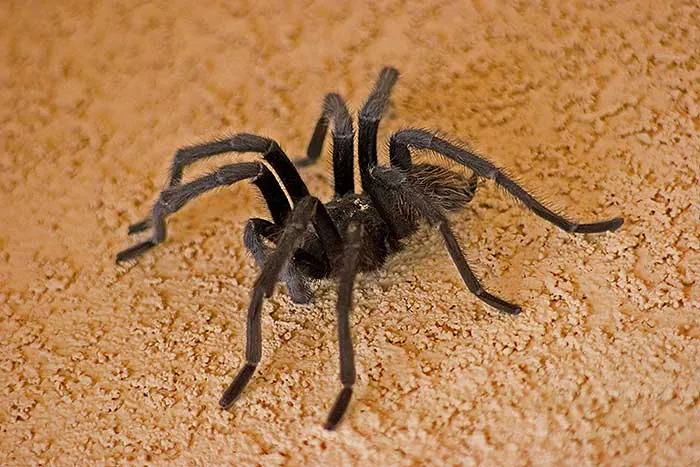Tarantula Bite Is It Poisonous? The Basics
The question of whether a tarantula bite is poisonous is a common one, and the answer is nuanced. While many people use the terms “poisonous” and “venomous” interchangeably, they have distinct meanings. In the context of tarantulas, understanding these differences is crucial for accurately assessing the risks and managing any potential health concerns. This article delves into the facts, providing a clear picture of what to expect if you encounter a tarantula bite. From the nature of their venom to first aid, we’ll explore what makes a tarantula bite a matter of concern and what you should do if you are bitten by one of these fascinating arachnids.
What Makes a Bite Potentially Harmful?
A tarantula bite can be harmful due to several factors. Firstly, the bite itself can cause mechanical damage, leading to puncture wounds. Secondly, the venom injected by the tarantula contains various compounds that can cause localized reactions. The severity of a bite depends on several elements, like the species of the tarantula, the amount of venom injected, and the individual’s sensitivity. The physical trauma from the fangs can cause pain, swelling, and redness at the bite site. This is often the immediate response experienced after a tarantula bite. Additionally, the venom introduces toxins which can trigger various physiological responses, as well as potential allergic reactions.
Venom vs. Poison Understanding the Difference

The terms “venomous” and “poisonous” are frequently misused. Venomous creatures inject toxins through a bite or sting, while poisonous creatures release toxins when touched or ingested. Tarantulas are venomous; they inject venom during a bite. This venom is a complex mixture of proteins, enzymes, and other substances designed to subdue prey. Therefore, when discussing tarantulas, the correct term is “venomous,” which highlights the delivery method of the toxins. This distinction is critical for correctly understanding the nature of the threat posed by a tarantula bite and how to respond appropriately.
Is Tarantula Venom Actually Poisonous?
Tarantula venom is not typically considered poisonous in the way some substances are. Instead, it is venomous, which means it’s delivered through a bite. The effects of a tarantula bite vary depending on the species, the amount of venom injected, and the individual’s sensitivity. Generally, tarantula venom is not lethal to humans. The primary effects are usually localized, such as pain, redness, and swelling at the bite site. However, it is important to consider individual allergic reactions, which can sometimes lead to more severe symptoms. Therefore, while tarantula venom is not typically lethal, it’s capable of causing discomfort and, in rare cases, more severe reactions, making the term “venomous” more accurate.
Top 5 Facts About Tarantula Bites
Fact 1 The Nature of Tarantula Venom

Tarantula venom is a complex cocktail of compounds, primarily designed to paralyze or subdue their prey, typically insects and small animals. The composition of the venom varies between species, affecting the type and severity of the bite’s effects. It generally contains enzymes and proteins that disrupt nerve function and cause localized tissue damage. The primary purpose is to aid in hunting and defense. The venom is not designed to be lethal to larger animals, like humans, but it can still cause significant discomfort and localized reactions.
Fact 2 The Primary Effects of a Tarantula Bite
The most common symptoms of a tarantula bite include immediate pain, often described as similar to a bee sting. Other effects include redness, swelling, itching, and sometimes muscle cramps at the bite site. Systemic reactions, although rare, can occur. In some sensitive individuals, this might lead to more severe symptoms, like nausea, vomiting, or, in extreme cases, an allergic reaction. However, the vast majority of tarantula bites result in localized discomfort rather than a systemic illness.
Fact 3 Severity Factors Size Species & Sensitivity
Several factors influence the severity of a tarantula bite. The species of tarantula plays a significant role, as venom composition varies. Some species have more potent venom than others. The size of the tarantula can also influence the amount of venom injected. Additionally, the individual’s sensitivity is important; some people may experience a stronger reaction due to allergies or other sensitivities. The location of the bite might also affect the severity. For instance, a bite on the face or neck might cause greater swelling and discomfort due to the area’s sensitive nature.
Fact 4 First Aid and Treatment Options

If bitten by a tarantula, immediate first aid includes washing the bite site with soap and water to reduce the risk of infection. Applying a cold compress can help alleviate pain and reduce swelling. Over-the-counter pain relievers, like ibuprofen or acetaminophen, can manage discomfort. It is essential to monitor for any signs of an allergic reaction, such as difficulty breathing, swelling of the face or throat, or dizziness. Should any of these severe symptoms occur, seek immediate medical attention. For most bites, these basic steps are sufficient.
Fact 5 Long-Term Effects and Complications
Generally, long-term complications from a tarantula bite are rare. Most people recover fully within a few days to a week. However, in some cases, secondary infections can occur if the bite site is not properly cleaned and cared for. Very rarely, allergic reactions might lead to more severe complications. In general, the long-term outlook for tarantula bites is positive, with most individuals experiencing no lasting effects. Always seek medical advice if you experience persistent or worsening symptoms after a bite.
Common Misconceptions About Tarantula Bites
Myth 1 All Tarantulas Are Deadly

One common misconception is that all tarantulas are deadly. This is far from the truth. While tarantulas are venomous and their bites can be painful, they are not generally life-threatening to humans. Most species have venom that causes localized reactions, such as pain and swelling. It’s important to differentiate between a painful bite and a deadly one. This misconception likely stems from the intimidating appearance of tarantulas and the general fear of spiders. Education and understanding are crucial to dispel this myth.
Myth 2 The Bite Is Always Fatal
Another common myth is that tarantula bites are always fatal. This is completely untrue. The venom of most tarantula species is not potent enough to cause death in humans. Although the bite can be painful and cause discomfort, it rarely leads to serious complications or fatalities. In the vast majority of cases, the effects are limited to localized symptoms, such as pain, redness, and swelling. The belief in fatality is largely fueled by fear and misinformation.
Myth 3 Antivenom Exists for All Tarantula Bites
Contrary to popular belief, antivenom is not available for all tarantula bites. Antivenom is typically developed for snakes and other venomous creatures that pose a significant threat. Because tarantula bites are generally not life-threatening, the development of widespread antivenom is not considered necessary. Treatment focuses on managing symptoms and providing supportive care. Understanding the availability of antivenom can set realistic expectations in case of a bite.
Conclusion Is a Tarantula Bite Poisonous?

In conclusion, a tarantula bite is technically venomous, not poisonous. While the bite can cause pain and localized reactions, it is typically not life-threatening to humans. Understanding the difference between venom and poison and the facts surrounding tarantula bites is crucial for managing expectations and providing appropriate care. Most bites result in minor symptoms. However, always monitor for severe reactions and seek medical attention if necessary. By dispelling myths and focusing on facts, we can better appreciate and safely coexist with these fascinating creatures.
